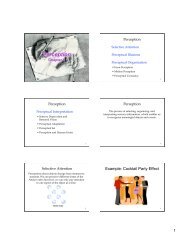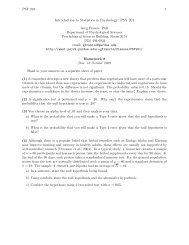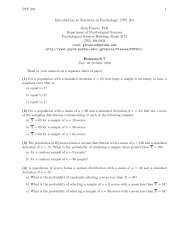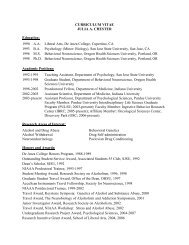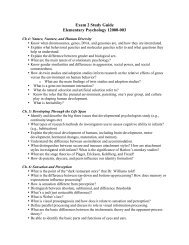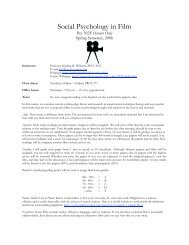Maxims or Myths of Beauty? A Meta-Analytic and Theoretical Review
Maxims or Myths of Beauty? A Meta-Analytic and Theoretical Review
Maxims or Myths of Beauty? A Meta-Analytic and Theoretical Review
You also want an ePaper? Increase the reach of your titles
YUMPU automatically turns print PDFs into web optimized ePapers that Google loves.
the<strong>or</strong>ies. However, we could not examine the presumed causal link<br />
between treatment <strong>and</strong> behavi<strong>or</strong> because only two studies exam-<br />
ined the contemp<strong>or</strong>aneous connections between treatment <strong>and</strong><br />
behavi<strong>or</strong> (S. M. Anderson & Bem, 1981; Snyder et al., 1977).<br />
Furtherm<strong>or</strong>e, we found no studies longitudinally investigating the<br />
links among judgment, treatment, <strong>and</strong> behavi<strong>or</strong> to determine an-<br />
tecedents <strong>and</strong> consequents. It is imp<strong>or</strong>tant f<strong>or</strong> future research to<br />
take on the task <strong>of</strong> properly evaluating this perspective.<br />
As the last step in the social model, targets should internalize the<br />
treatment they receive <strong>and</strong> develop different self-views. We found<br />
only weak supp<strong>or</strong>t f<strong>or</strong> the assertion that attractive <strong>and</strong> unattractive<br />
adults have different self-views: Attractive adults had m<strong>or</strong>e posi-<br />
tive self-views than unattractive adults did, although the effect<br />
sizes are not large. Furtherm<strong>or</strong>e, we could not evaluate whether<br />
differential treatment causes different self-views because <strong>of</strong> the<br />
lack <strong>of</strong> such studies in the primary literature.<br />
Although all <strong>of</strong> these assumptions must be documented f<strong>or</strong><br />
social the<strong>or</strong>y to account f<strong>or</strong> attractiveness effects, certain patterns<br />
<strong>of</strong> age <strong>and</strong> gender differences would provide additional supp<strong>or</strong>t f<strong>or</strong><br />
the the<strong>or</strong>y. Contrary to the predictions <strong>of</strong> the the<strong>or</strong>y, however, our<br />
results showed that f<strong>or</strong> judgment, treatment, <strong>and</strong> behavi<strong>or</strong>/traits,<br />
attractiveness is just as imp<strong>or</strong>tant f<strong>or</strong> children as f<strong>or</strong> adults <strong>and</strong> f<strong>or</strong><br />
males as f<strong>or</strong> females. Perhaps behavi<strong>or</strong>al differences do increase<br />
with age but could not be detected in the research we retrieved,<br />
which primarily examined only children ages 6 <strong>and</strong> older. A<br />
similar explanation also may be pertinent f<strong>or</strong> the lack <strong>of</strong> age<br />
differences in judgment <strong>and</strong> treatment. Thus, the lack <strong>of</strong> research<br />
with very young children seriously hampers either a strong en-<br />
d<strong>or</strong>sement <strong>or</strong> indictment <strong>of</strong> a social account.<br />
Socialization <strong>and</strong> Social Expectancy The<strong>or</strong>ies:<br />
Evaluation <strong>and</strong> Future Directions<br />
On the basis <strong>of</strong> our overall effect sizes f<strong>or</strong> reliability, judgment,<br />
treatment, <strong>and</strong> behavi<strong>or</strong>/traits, we conclude that social the<strong>or</strong>y is a<br />
plausible but largely unproven explanation <strong>of</strong> attractiveness effects<br />
(see Table 11). The the<strong>or</strong>y accurately predicted within-culture<br />
agreement in evaluations <strong>of</strong> attractiveness but missed the mark in<br />
asserting the imp<strong>or</strong>tance <strong>of</strong> cultural influences f<strong>or</strong> judgments <strong>of</strong><br />
attractiveness across cultures. We also observed a significant de-<br />
ficiency in the extant research evaluating social the<strong>or</strong>y: the lack <strong>of</strong><br />
research linking expectations to judgments, judgments to treat-<br />
ment, <strong>and</strong> treatment to behavi<strong>or</strong>al outcomes. F<strong>or</strong> the social account<br />
to be convincing, the components (judgment, treatment, <strong>and</strong> be-<br />
havi<strong>or</strong>) must be causally related to one another. Neither this<br />
meta-analysis n<strong>or</strong> primary research has shown causality; rather, we<br />
have shown that attractiveness is c<strong>or</strong>related independently with<br />
each <strong>of</strong> the components. When enough studies <strong>of</strong> relations among<br />
the components are available, future meta-analysts could model<br />
plausible causal pathways (see, e.g., Shadish, 1996). At a mini-<br />
mum, however, failure to find c<strong>or</strong>relations among judgment, treat-<br />
ment, <strong>and</strong> behavi<strong>or</strong> as a function <strong>of</strong> attractiveness could clearly<br />
rule out social the<strong>or</strong>y as a plausible explanation.<br />
Three types <strong>of</strong> future studies are necessary to establish a causal<br />
link among the components <strong>of</strong> social the<strong>or</strong>y: studies using con-<br />
ceptually similar variables, studies that are longitudinal, <strong>and</strong> stud-<br />
ies <strong>of</strong> very young children. First, studies <strong>of</strong> judgment, treatment,<br />
<strong>and</strong> behavi<strong>or</strong> must assess variables that bear some conceptual<br />
relation to each other f<strong>or</strong> each domain. Because the literature is<br />
MAXIMS OR MYTHS OF BEAUTY 405<br />
currently fractionated into studies <strong>of</strong> impressions, studies <strong>of</strong> judg-<br />
ments, studies <strong>of</strong> treatment, <strong>and</strong> studies <strong>of</strong> target behavi<strong>or</strong>, little<br />
attempt has been made to define variables conceptually <strong>and</strong> to<br />
measure them simultaneously across the different domains. Sec-<br />
ond, future research should conduct longitudinal studies to deter-<br />
mine which components, if any, are antecedent. Attractive <strong>and</strong><br />
unattractive children may behave differently at birth as a result <strong>of</strong><br />
biologically based characteristics c<strong>or</strong>related with attractiveness<br />
(see, e.g., Field & Vega-Lahr, 1984; Gangestad, Thomhill, & Yeo,<br />
1994; Halverson & Vict<strong>or</strong>, 1976; Waldrop & Halverson, 1971).<br />
Perceivers may detect these differences accurately <strong>and</strong>, as a result,<br />
judge <strong>and</strong> treat attractive <strong>and</strong> unattractive individuals differently.<br />
In contrast, social the<strong>or</strong>y makes a clear, falsifiable prediction about<br />
the <strong>or</strong>der <strong>of</strong> emergence <strong>and</strong> the causal relations among judgment,<br />
treatment, <strong>and</strong> behavi<strong>or</strong>: Differential judgment <strong>and</strong> treatment cause<br />
the development <strong>of</strong> different behavi<strong>or</strong>s <strong>and</strong>, thus, must precede the<br />
emergence <strong>of</strong> behavi<strong>or</strong>al differences. Longitudinal research would<br />
allow a clear demonstration <strong>of</strong> whether behavi<strong>or</strong>al differences as a<br />
function <strong>of</strong> attractiveness precede, coincide with, <strong>or</strong> follow differ-<br />
ential judgment <strong>and</strong> treatment. Thus, it is essential to conduct<br />
research on very young children to disentangle these hypotheses.<br />
We retrieved only four studies <strong>of</strong> behavi<strong>or</strong>al differences as a<br />
function <strong>of</strong> attractiveness in children younger than age 6. If such<br />
research finds that behavi<strong>or</strong>al differences precede differential<br />
judgment <strong>and</strong> treatment, social the<strong>or</strong>y could be eliminated as the<br />
sole the<strong>or</strong>etical account <strong>of</strong> attractiveness effects, although certainly<br />
subsequent differential judgment <strong>and</strong> treatment could augment the<br />
display <strong>of</strong> different behavi<strong>or</strong>s <strong>and</strong> traits.<br />
Another deficiency we observed is the div<strong>or</strong>ce between social<br />
the<strong>or</strong>y <strong>and</strong> the data concerning gender differences. We did not find<br />
the expected gender differences in the imp<strong>or</strong>tance <strong>of</strong> attractive-<br />
ness, although perhaps we could not detect them because much<br />
extant research examined only a single gender <strong>or</strong> did not distin-<br />
guish between males <strong>and</strong> females in the data analysis. Future<br />
research must rep<strong>or</strong>t differences in the effects <strong>of</strong> attractiveness f<strong>or</strong><br />
males <strong>and</strong> females separately bef<strong>or</strong>e social the<strong>or</strong>y can be conclu-<br />
sively evaluated.<br />
Fitness-Related Evolutionary The<strong>or</strong>ies<br />
Fitness-related evolutionary the<strong>or</strong>ies (good genes, human mate<br />
selection, differential parental solicitude) all agree that because<br />
m<strong>or</strong>phological characteristics such as facial attractiveness are hon-<br />
est indicat<strong>or</strong>s <strong>of</strong> fitness, health, quality, <strong>and</strong> reproductive value,<br />
attractiveness should be imp<strong>or</strong>tant in human interactions (Barber,<br />
1995; Buss & Schmitt, 1993; Daly & Wilson, 1995; Symons,<br />
1979; Th<strong>or</strong>nhill & Gangestad, 1993). All three models agree that<br />
perceivers should consistently detect <strong>and</strong> recognize attractiveness,<br />
both within <strong>and</strong> across cultures, because humans have evolved<br />
universal st<strong>and</strong>ards <strong>of</strong> facial attractiveness based on clues to health<br />
<strong>and</strong> reproductive fitness. Furtherm<strong>or</strong>e, as an evolved trait, agree-<br />
ment about attractiveness should be evident within as well as<br />
between cultures. As we have shown with reliability, this criterion<br />
has been met, <strong>and</strong> all three fitness-related the<strong>or</strong>ies have proven to<br />
be m<strong>or</strong>e predictively accurate than social the<strong>or</strong>y in this regard.<br />
Mate selection. Mate-selection the<strong>or</strong>y makes clear predictions<br />
about the imp<strong>or</strong>tance <strong>of</strong> attractiveness. The the<strong>or</strong>y focuses many <strong>of</strong><br />
its predictions on gender differences in the imp<strong>or</strong>tance <strong>of</strong> attrac-<br />
tiveness because the the<strong>or</strong>y is concerned primarily with the devel-


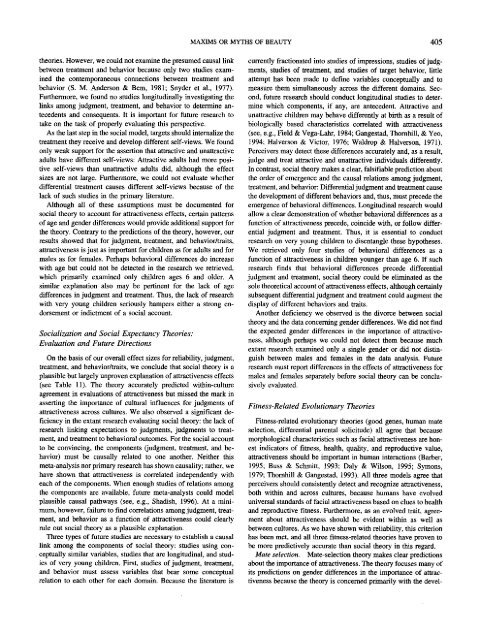


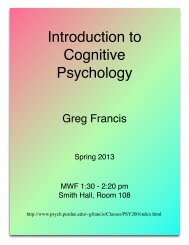

![Exam 4 Study Guide[1]](https://img.yumpu.com/45196739/1/190x245/exam-4-study-guide1.jpg?quality=85)
